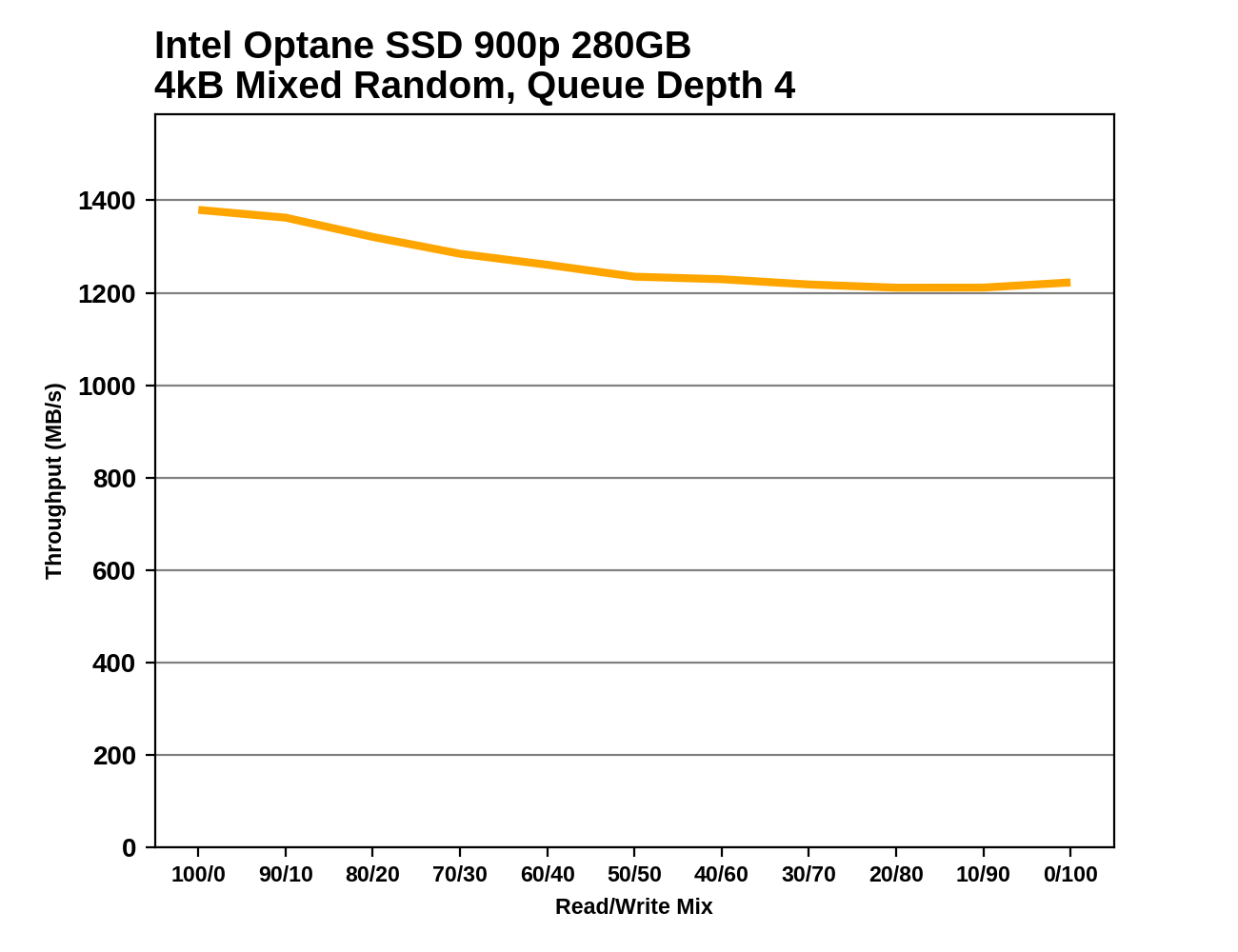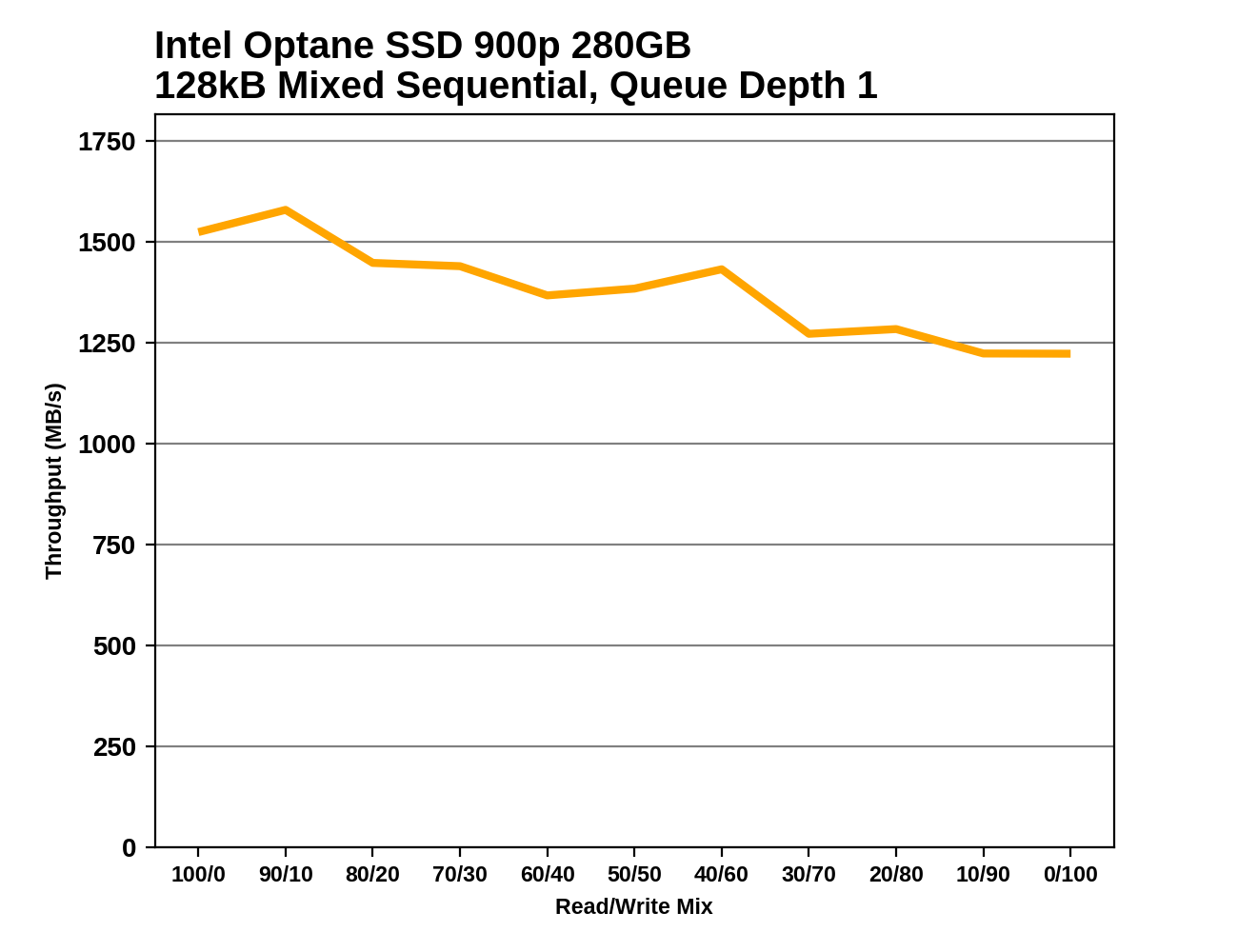The Intel Optane SSD 900P 280GB Review
by Billy Tallis on October 27, 2017 9:30 AM ESTMixed Random Performance
Our test of mixed random reads and writes covers mixes varying from pure reads to pure writes at 10% increments. Each mix is tested for up to 1 minute or 32GB of data transferred. The test is conducted with a queue depth of 4, and is limited to a 64GB span of the drive. In between each mix, the drive is given idle time of up to one minute so that the overall duty cycle is 50%.

The mixed random I/O performance of the Intel Optane SSD 900P is completely unmatched. The small Optane Memory M.2 is the second fastest drive we've tested, and the fastest flash-based SSD is only a third as fast as the Optane SSD overall.
 |
|||||||||
At the very end of the test, when the workload shifts to pure random writes, Samsung's fastest SSDs are able to batch the writes and dramatically improve throughput, almost enough to catch up to the slowest speed the Optane SSD hits during this test.
Mixed Sequential Performance
Our test of mixed sequential reads and writes differs from the mixed random I/O test by performing 128kB sequential accesses rather than 4kB accesses at random locations, and the sequential test is conducted at queue depth 1. The range of mixes tested is the same, and the timing and limits on data transfers are also the same as above.

The Intel Optane SSD 900P doesn't quite dominate the mixed sequential I/O test to the extent that it trounced the competition in the mixed random I/O test, but it still breaks the record with a 40% higher average throughput than the fastest flash-based SSD.
 |
|||||||||
The Optane SSD 900P's performance wavers a bit as the workload changes, but the general trend is a gradual reduction in performance as the proportion of writes increases. The flash-based SSDs tend to show an sharper decline in performance during the first half of the test, and the good ones recover most of that performance over the course of the second half. But the low performance in the middle of the test brings the averages way down and leaves the Optane SSD alone at the top.










205 Comments
View All Comments
Meteor2 - Tuesday, October 31, 2017 - link
I always switch to 'read comments as a single page'mapesdhs - Tuesday, October 31, 2017 - link
I've used the scroll wheel so much, I had to buy a new mouse... :}Rektide - Friday, October 27, 2017 - link
Does the P4800X self-destruct/go-read-only after it reaches the advertised 20.5 PBW endurance?That's twice what a Samsung 850 Pro managed in a stress test, but the Pro is a consumer class device. The idea that I'd buy some fancy enterprise drive that would stop operation the second it's endurance rating is over makes me fume.
mkozakewich - Monday, October 30, 2017 - link
From what I've heard, they never stop. At that point, they'll be out of warranty, but they'll continue to work at poorer and poorer performance levels.FwFred - Friday, October 27, 2017 - link
I see the comments are 50/50 impressed vs not impressed by this review. I also see that ddriver is 50% of the comments 😂Notmyusualid - Friday, October 27, 2017 - link
@FwFredIndeed. I thought the drive was amazing. I guess ddriver read some other article.
todd.nonja - Monday, October 30, 2017 - link
I needed a good laugh after wading through the muck that ddriver has been spewing. Thanks for that!mapesdhs - Tuesday, October 31, 2017 - link
Definite lol marker point. :Diwod - Friday, October 27, 2017 - link
The price is much cheaper then I thought!. For what it is capable of I think this is actually cheap. This is a first gen ( third ? ) product. So i expect there should still be lots of headroom for improvement. But i still struggle to find the use of it in normal day to day computing.While latency is extremely important, you dont want your system to Jank or halt, but newer SSD is nearly avoided the problem. And as NAND gets cheaper ( Which isn't happening.... ) and better controller, I would call this problem solved.
SSD continues to uses less power, something that is important in Laptop market. And for 99% of our workload we are no longer limited by I/O. As shown in the benchmark with very little performance improvement, why should i get a Optane is an question that needs better answer from Intel.
What i think will be interesting, is the use of Optane SSD on Database server, with those kind of latency, Random Read Write, and Endurance, it think this is going to be a gigantic leap forward.
DanNeely - Friday, October 27, 2017 - link
Yup. I was expecting it to be several times more expensive. Still more than I'd be willing to spend if building a new system but only; only because I don't think I could live with only half a TB for long before running low on space, and I don't want to do the multiple drives thing again. (I currently have about 400GB used on a 1 TB SSD). 2nd/3rd gen in 2-4 years when I build my new system I could see dropping $500ish for a ~2TB model if it exists then.